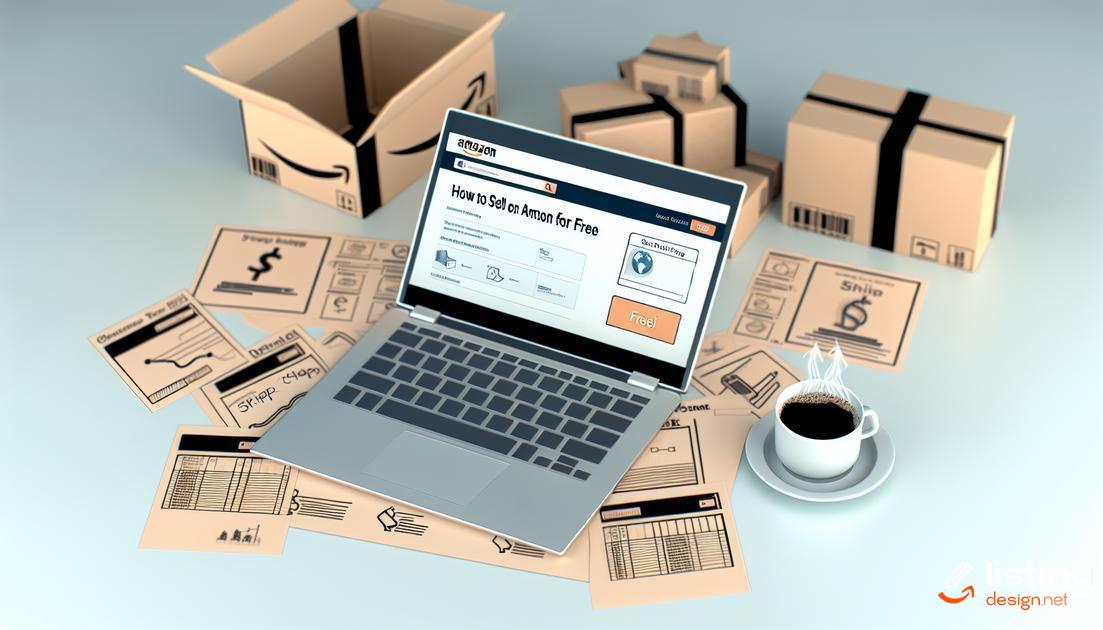Are you wondering how to sell on Amazon for free without spending any money upfront? Selling on Amazon offers immense opportunities, but many assume you need a significant investment. Thankfully, there are practical ways to start selling on Amazon without breaking the bank. In this guide, we will cover key steps such as setting up a seller account, listing products, using free promotional tactics, and leveraging Amazon’s built-in tools. Let’s dive in and explore how you can begin your Amazon selling journey cost-effectively.
Table of Contents
Getting Started with Selling on Amazon
When getting started with selling on Amazon, begin by creating an Amazon seller account. You can choose between an Individual or Professional account. Opt for the Individual plan if you plan to sell fewer than 40 items per month. This plan has no monthly fee, making it an excellent choice for small-scale sellers.
Next, familiarize yourself with Amazon’s Seller Central dashboard, your main hub for managing sales, inventory, and customer interactions. Take advantage of the resources and tutorials provided by Amazon to navigate its features effectively. Ensure you understand Amazon’s policies and guidelines to avoid any issues down the line.
Another crucial step is to research the market and choose the right products to sell. Use Amazon’s Best Sellers and trending lists to identify high-demand products. Competitive analysis can help you understand pricing and positioning strategies. Utilize free tools like Google Trends and Amazon’s search bar to gather insights on popular search terms.
Finally, gather all necessary information about the products you intend to sell. This includes detailed descriptions, clear images, and accurate pricing. Preparing this information in advance will streamline the listing process, setting a strong foundation for your Amazon selling journey.
Understanding Amazon Seller Accounts

Amazon offers two types of seller accounts: Individual and Professional. The main difference is their fee structure and feature sets. Individual accounts are suitable for those who sell less than 40 items per month and don’t need advanced selling tools. There’s no monthly subscription fee, but you pay $0.99 per item sold. This option is ideal for beginners testing the waters.
On the other hand, the Professional account is designed for more serious sellers. It costs $39.99 per month but doesn’t charge the per-item fee. This account unlocks extra features like bulk listings, access to Amazon Marketplace Web Services (MWS), and eligibility for top placement on product detail pages. These tools can significantly enhance your selling experience.
When deciding between the two, consider your sales volume and whether the advanced features justify the monthly fee.
Listing Your Products for Free
When it comes to listing your products for free on Amazon, you’re in luck. Amazon offers several ways to list your products without having to pay any fees initially. The first step is to choose the right Amazon Seller Account for your needs. While there are two main types—Individual and Professional—opting for an Individual account can be more cost-effective if you’re planning to sell fewer than 40 items per month.
Once your account is set up, you can list products by navigating to the Inventory section and selecting ‘Add a Product’. You will need to input details such as product title, description, price, and quantity. It is crucial to be as detailed as possible because a well-detailed listing attracts more customers.
Amazon provides a Product Listing Tool that simplifies the process. This tool allows you to list multiple products at once by uploading a spreadsheet. Make sure to follow the guidelines provided by Amazon for filling out the spreadsheet correctly to avoid any errors.
Additionally, you can utilize the A+ Content Manager, which is available for free under the Individual plan. This feature allows you to enhance your standard product descriptions with more detailed information and rich content, like images and charts, to better appeal to customers.
Another tip for listing your products without any cost is making use of the Amazon Marketplace Web Service (MWS). This tool allows you to integrate your inventory management system with Amazon’s platform, enabling streamlined listing and management of multiple products at no extra charge.
Finally, consider taking advantage of Fulfillment by Amazon (FBA) for broader reach and potentially higher sales, although it does come with its own set of fees. Selling on Amazon for free is possible but requires strategic use of the platform’s available tools and features.
Optimizing Product Listings for Free

Optimizing Product Listings
To maximize visibility without spending money, focus on keyword optimization. Use tools like Google Keyword Planner to find relevant search terms. Incorporate these naturally into your product title, description, and bullet points.
High-quality images are crucial. Ensure they are clear and show the product from multiple angles. Use Amazon’s guidelines to avoid any issues. Adding videos can also improve your listing’s appeal.
Customer reviews hugely impact your rankings. Encourage satisfied customers to leave positive reviews, and respond to feedback promptly. Engage with your customers to build trust and improve your product’s rating.
Use Amazon’s Enhanced Brand Content (EBC) if you’re a brand registered seller. This allows for richer text placements and helps in driving more conversions. For non-brand registered sellers, focus on making your product descriptions informative and engaging.
Regularly update your listings with new information and optimize them based on customer feedback and changes in search trends. Continuous improvement is key to staying competitive.
Using Social Media for Free Promotions
One of the powerful ways to promote your products for free is through social media. You can use platforms like Facebook, Instagram, Twitter, and Pinterest to reach a broader audience without any cost.
Share Engaging Content: Create posts that showcase your products in an attractive way. Use high-quality images and engaging descriptions to capture the attention of potential buyers.
Utilize Hashtags:
Hashtags help increase the visibility of your posts. Research and use relevant hashtags that your target audience might search for.
Engage with Your Audience: Respond to comments, ask questions, and interact with your followers to build a community around your brand. Engagement can drive more traffic to your Amazon listings.
Leverage Video Content:
Platforms like Instagram and Facebook offer features like stories and live videos. Use these to give a behind-the-scenes look at your products, show how they are made, or demonstrate their benefits.
Run Contests and Giveaways: Encourage your followers to share your content and tag their friends by running contests and giveaways. This can increase your reach and attract more potential customers.
With these strategies, you can maximize your social media presence and drive free traffic to your Amazon listings, ultimately boosting your sales.
How to Leverage Amazon’s Free Tools

Amazon provides a variety of free tools to help sellers maximize their potential. These tools are designed to assist in various aspects of your business, from product research to customer engagement.
One essential tool is the Amazon Seller Central dashboard. This comprehensive platform offers functionalities to manage inventory, monitor sales performance, and communicate with customers. The dashboard’s intuitive design makes it easier for sellers to navigate and leverage data for informed decision-making.
Another useful tool is the Amazon Analytics. This free tool provides valuable insights into your sales and customer behavior. By analyzing this data, you can identify trends, optimize your listings, and better understand your audience.
Amazon also offers the A+ Content Manager for sellers who want to enhance their product listings. This tool allows you to add rich content such as high-quality images and detailed product descriptions to improve the customer’s shopping experience and increase conversion rates.
For those looking to streamline their shipping processes, Amazon’s FBA (Fulfillment by Amazon) Calculator is a must-have. This tool helps you estimate the costs of using FBA services, allowing you to make cost-effective shipping decisions.
Finally, the Amazon Seller App provides the freedom to manage your store on the go. With this app, you can scan products, track sales, and respond to customer inquiries directly from your mobile device.
Utilizing these free tools can significantly enhance your efficiency and overall success on Amazon, ultimately helping you grow your business without incurring additional costs.
Customer Service and Handling Returns
One of the key aspects of maintaining a successful Amazon store is providing exceptional customer service. Respond promptly to customer inquiries to build trust and increase satisfaction. Communication is crucial; always address issues with politeness and professionalism.
When it comes to handling returns, familiarize yourself with Amazon’s return policy. Having a clear, hassle-free return process can improve your store’s reputation. Make it easy for customers to return items by providing them with instructions and labels upfront.
Make sure to process refunds promptly and communicate with the customer throughout the process. This shows that you care about their experience, even after a sale is completed. Effective return handling can turn a potentially negative experience into a positive one.
Analyse return data to identify patterns or recurring issues. Address these problems to minimize future returns and improve product quality. Maintaining high standards in both customer service and return handling is essential for successful selling on Amazon.
Tips for Maintaining a Successful Amazon Store

Stay Updated with Amazon’s Policies
Amazon’s policies frequently change, and staying updated can help you avoid penalties. Regularly check Amazon’s Seller Central for new updates and guidelines.
Maintain High Product Quality
Customers expect high-quality products. Ensure your products meet all safety and quality standards to maintain customer satisfaction and minimize returns.
Excellent Customer Service
Be responsive to customer inquiries and complaints. Use Amazon’s messaging system to communicate effectively and resolve issues quickly.
Optimize Your Inventory Management
Monitor your inventory levels to prevent stockouts or overstocking. Use Amazon’s free tools like Inventory Performance Index (IPI) to optimize stock levels.
Regularly Update Listings
Keep your product listings updated with accurate descriptions, images, and pricing. Regular updates can help improve your product visibility and sales.
Utilize Customer Reviews
Encourage satisfied customers to leave reviews. Positive reviews can enhance your product’s reputation and attract more buyers. Address negative reviews promptly to show you care about customer feedback.
Analyze Sales Data
Regularly review your sales data to identify trends and areas for improvement. Use Amazon’s sales reports to gain insights into your sales performance and adjust your strategies accordingly.
Offer Competitive Pricing
Keep an eye on your competitors’ pricing strategies and adjust your prices to stay competitive. Use Amazon’s Automate Pricing tool to remain competitive without constantly monitoring prices.
Promote Your Store through Social Media
Leverage social media platforms to promote your Amazon store. Create engaging content that directs traffic to your product listings.
Stay Organized
Maintain an organized system for tracking orders, inventory, and customer communications. Efficient organization can enhance your store’s efficiency and prevent costly mistakes.


